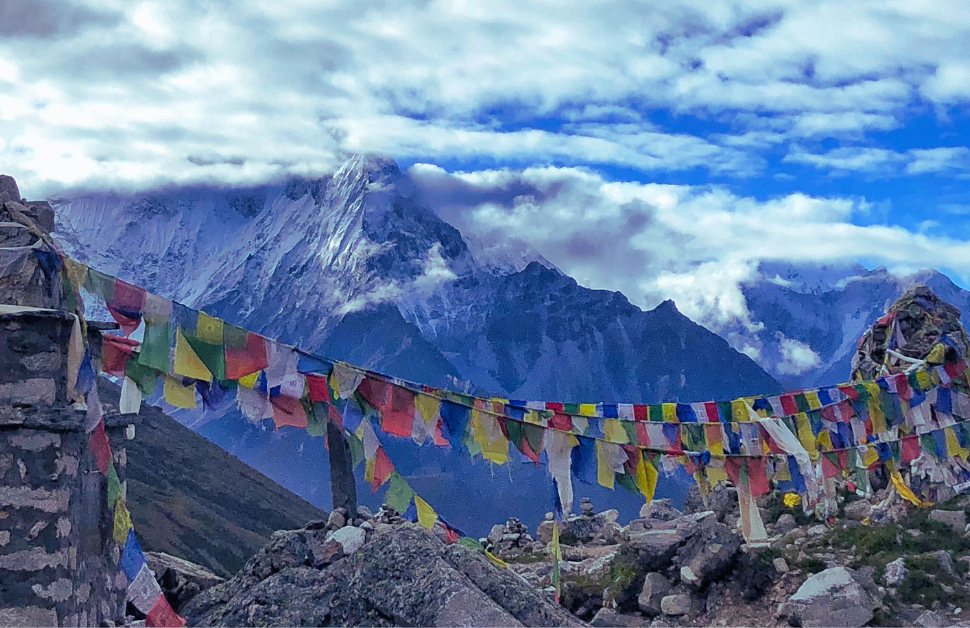Tsum Valley is located north of Gorkha, which is one of Nepal’s most beautiful and culturally rich regions. It is home to Buddhist monks and nuns living in harmony, preserving ancient Tibetan culture. Among its treasures is Mu Gompa, a symbol of the region’s deep cultural heritage and spiritual significance. As one of the oldest monasteries in the area, Mu Gompa provides visitors with a unique opportunity to explore the traditions of Tibetan Buddhism while being immersed in the breathtaking beauty of the Himalayas.
In this blog, we will uncover the charm of Mu Gompa, delve into its historical and cultural importance, and provide essential information for travelers looking to visit this serene and spiritually rich destination.
The Enchanting Allure of Mu Gompa
Mu Gompa is more than just a monastery; it is a sanctuary for those seeking peace and enlightenment. Located at an altitude of 3,700 meters (12,139 feet), views of the surrounding landscape in Mu Gompa are more than ordinary. The rugged terrain, characterized by stark mountains, deep valleys, and arid plateaus, creates a breathtaking backdrop that melts the hearts of trekkers and spiritual seekers alike.
The monastery serves as a spiritual haven for monks and visitors alike, fostering a deep connection with Tibetan Buddhism. Its serene environment encourages reflection and meditation, making it an ideal destination for those looking to escape the chaos of modern life. Visitors can participate in daily rituals, attend teachings, and experience the warmth of the local community, all of which enhance the overall experience. You can visit this website for further information on buddhist monks and nunnery who live in Mu Gompa.
A Historical Perspective on Mu Gompa
The origins of Mu Gompa stretch back centuries, its foundation veiled in mystery and intertwined with the ancient history of the Tsum Valley. Established long ago, Mu Gompa has long served as a sanctuary for spiritual growth and a beacon of Tibetan Buddhist tradition in the remote valleys of the Himalayas. Throughout its history, the monastery has been a focal point for learning, meditation, and community engagement. Monks here dedicate their lives to preserving the sacred teachings of Tibetan Buddhism, including ancient rituals and cultural practices passed down through generations. At the heart of this spiritual endeavor is the revered Lama Zopa Rinpoche, who plays a pivotal role in guiding the monastery’s spiritual mission and ensuring the preservation of its rich heritage.
Beyond its spiritual significance, Mu Gompa holds an important place in the region’s history due to its strategic location along ancient trade routes that once connected Nepal and Tibet. These well-trodden paths served as conduits for commerce, culture, and ideas, making Mu Gompa a key destination for traders, pilgrims, and spiritual seekers alike. The monastery’s location fostered cultural exchanges between the two great Himalayan regions, enriching the lives of the people who passed through and leaving a lasting legacy of shared traditions and beliefs. For centuries, it stood as a hub where knowledge, spirituality, and cultural practices were interwoven with the daily lives of those who lived in or visited the valley.
The architecture and artistry of Mu Gompa further enhance its historical value. Inside its ancient walls, the monastery is adorned with exquisite murals and thangkas—traditional Tibetan paintings that illustrate stories from Buddhist scriptures and depict sacred symbols of Tibetan Buddhism. These intricate artworks are not only aesthetically captivating but also serve as teaching tools, offering deep insights into the spiritual beliefs and philosophies that have shaped the lives of the Tsumba people for centuries. Each brushstroke carries with it a piece of history, reflecting the spiritual devotion of the artists and the cultural significance of the monastery itself.
Today, Mu Gompa stands as a living testament to the resilience of Tibetan Buddhism in the face of time and changing circumstances. It continues to attract visitors from around the world, both for its spiritual offerings and its cultural significance. Those who visit can immerse themselves in the tranquil beauty of the monastery, experience the peaceful rhythms of monastic life, and witness firsthand the enduring legacy of Mu Gompa as it continues to serve as a spiritual sanctuary and cultural treasure in the heart of the Himalayas.
Trekking to Mu Gompa: An Unforgettable Adventure
Reaching Mu Gompa is an adventure that takes you through some of the most stunning landscapes in Nepal. The journey typically begins in the bustling town of Jomsom, where trekkers can acclimatize before embarking on their trek to the monastery. The journey offers stunning landscapes along the way. The location itself offers a great environment to explore that is equally tough and fulfilling. Here’s an overview of the common trekking routes to Mu Gompa:
Jomsom to Mu Gompa Trekking Route
- Jomsom to Kagbeni (2,800 m): The first leg of the trek takes you from Jomsom to Kagbeni, a picturesque village that serves as the gateway to Upper Mustang. The trail winds alongside the Kali Gandaki River, offering spectacular views of the Dhaulagiri and Annapurna mountain ranges. This portion of the trek usually takes about 2 to 3 hours.
- Kagbeni to Tsaile (3,050 m): Continuing from Kagbeni, the trek to Tsaile takes approximately 4 to 5 hours. The trail passes through lush fields and ancient ruins, allowing trekkers to experience the local culture and hospitality. The landscape gradually becomes more arid, reflecting the unique geography of Upper Mustang.
- Tsaile to Ghami (3,520 m): The next leg of the journey involves a trek to Ghami, which takes about 5 to 6 hours. The path is characterized by stunning cliffs and expansive views of the Tibetan Plateau. Ghami is known for its traditional mud-brick houses and welcoming atmosphere, making it a perfect place to rest.
- Ghami to Mu Gompa (3,700 m): The final stretch of the trek to Mu Gompa usually takes about 5 hours. The trail ascends gradually, offering breathtaking views of the surrounding mountains. Upon arrival at the monastery, trekkers are greeted by the sight of ancient structures and the serene ambiance of spiritual practice.
Best Time to Visit Mu Gompa
The ideal time for trekking to Mu Gompa is during the spring (March to May) and autumn (September to November) seasons. During these months, the weather is generally mild, with clear skies and moderate temperatures, making it perfect for trekking. In spring, the landscape comes alive with colorful flowers, while autumn offers stunning views of the snow-capped peaks against the vibrant blue sky.
Cultural Significance of Mu Gompa
Mu Gompa is a place of spiritual importance as well as a valuable cultural treasure. The monastery plays a crucial role in preserving Tibetan Buddhist traditions and teachings, which is managed by the Lama community and their chosen master. The monastery in Mu Gompa is home to ancient texts, scriptures, and artifacts that are invaluable for understanding the rich history of the region.
One of the most notable events celebrated at Mu Gompa is the Tiji Festival. This vibrant festival, celebrated in May, symbolizes the victory of good over evil and features colorful dances, music, and rituals that engage both locals and visitors. Participating in such festivals provides travelers with an opportunity to immerse themselves in the vibrant culture of the Mustang region.
The Spiritual Experience at Mu Gompa
For many visitors, a trip to Mu Gompa is a deeply spiritual experience. The peaceful atmosphere encourages reflection and self-discovery. Visitors can engage in various spiritual practices, including meditation, prayer, and attending teachings led by the resident monks. The monastery’s tranquil surroundings provide an ideal setting for those seeking inner peace and a deeper connection to their spiritual journey.
Practical Tips for Visiting Mu Gompa
- Permits: To trek in the Mustang region, travelers must obtain special permits. The Restricted Area Permit is required to explore the Upper Mustang, along with the Annapurna Conservation Area Permit (ACAP). We, being a licensed trekking agency, will arrange these permits.
- Guided Treks: While it is possible to trek independently, hiring a local guide can significantly enhance your experience. Upon booking a trip with Manasukh, we will provide a knowledgeable guide who can offer insights into the local culture, history, and geography, making your journey more enriching and informative.
- Packing Essentials: Packing the right gear is crucial for a successful trek. Essential items include warm clothing, trekking boots, a durable backpack, a sleeping bag, and personal toiletries. It’s also important to carry enough water and high-energy snacks to sustain you during the trek.
- Acclimatization: Given the high altitude of Mu Gompa, acclimatization is vital. Take your time during the trek, allowing your body to adjust to the elevation. Listen to your body and make adjustments to your pace as necessary.
- Respect Local Customs: When visiting the monastery, it is essential to be respectful of local customs and traditions. Dress modestly, remove your shoes before entering the sacred spaces, and be mindful of any ongoing rituals or ceremonies.
- Health and Safety: Staying hydrated and maintaining a balanced diet is crucial while trekking. Carry a first aid kit with basic medications, and consider bringing altitude sickness medication if you have a history of altitude-related issues.
Connecting with the Local Community
One of the highlights of visiting Mu Gompa is the opportunity to connect with the local community. The people of Mustang are known for their warm hospitality and rich cultural traditions. Engaging with locals provides insight into their way of life, customs, and values.
Visitors can participate in community events, share meals with local families, and learn about traditional crafts and practices. You can also visit the monastery and be a part of the community upon a request. These interactions enrich the overall experience, fostering a deeper appreciation for the cultural diversity of the region.
The Unique Flora and Fauna of the Mustang Region
The Mustang region is not only known for its stunning landscapes but also for its unique flora and fauna. The diverse ecosystem supports various plant species adapted to the harsh climate and altitude. Trekkers may encounter medicinal herbs, vibrant wildflowers, and resilient shrubs along the trails. The trekkers will pass through the route, where Yarchagumba(Kira) is found.
Wildlife enthusiasts will be delighted to know that the region is home to several unique animal species. Keep an eye out for blue sheep, snow leopards, and various bird species, including the elusive Himalayan griffon. Observing these animals in their natural habitat adds another layer of excitement to your trekking experience.
Personal Stories: Trekkers’ Experiences at Mu Gompa
The allure of Mu Gompa has drawn countless trekkers and spiritual seekers from around the world. Here are a few personal stories that highlight the impact of this sacred destination:
- A Journey of Self-Discovery: For many, the trek to Mu Gompa is a transformative experience. One traveler shared how the solitude and serenity of the monastery allowed them to confront personal challenges and gain clarity in their life. The peaceful atmosphere and the teachings of the monks inspired them to embrace mindfulness and self-reflection.
- Cultural Immersion: Another trekker recounted their experience of participating in the Tiji Festival. The vibrant colors, rhythmic dances, and communal celebrations created a sense of belonging and connection to the local culture. They left Mu Gompa not only with memories of breathtaking landscapes but also with a deeper understanding of Tibetan Buddhist traditions.
- A Spiritual Awakening: A spiritual seeker shared how their visit to Mu Gompa ignited a profound sense of purpose. Engaging in meditation and prayer with the monks helped them reconnect with their spiritual path and set intentions for their future. The experience at Mu Gompa served as a catalyst for their personal growth and exploration.
Conclusion
Mu Gompa is far more than just a destination; it’s an immersive journey into the spiritual heart of Tibetan Buddhism and the awe-inspiring landscapes of the Mustang region. With its deep-rooted history, profound cultural significance, and tranquil environment, Mu Gompa provides the perfect setting for reflection, meditation, and spiritual rejuvenation. Whether you’re drawn by the allure of adventure, seeking spiritual growth, or aiming to gain a deeper understanding of Tibetan traditions, a visit to Mu Gompa promises to be a transformative experience.
This hidden gem invites travelers to uncover its timeless beauty and embrace the serenity that can only be found in such a sacred place. Plan your visit to Mu Gompa with Manasukh today.


